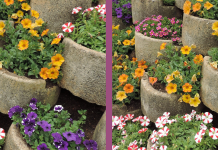Did you know that plants can have an effect on you? Those with bright flowers or vibrant foliage are energising, while softer colours and round leaves are calming. Green has always been a harmonious colour so plenty of green is always a good idea.
If you are working at a computer, its necessary to take a break at least every 30 minutes. Keep plants with interesting textures and pattens nearby to rest your eyes on and you will be drawn into contemplating their amazing colours and textures. A good exercise in mindfulness.
In the Netherlands, where indoor plants are hugely popular, they now refer to brain stimulating plants such as Begonia Polka Dot, cacti and other plants with highly patterned or configured leaves.

Green leaved plants are great for improving air quality so it’s a good idea to mix in some of those with exceptional air purifying qualities like peace lilies (Spathiphyllum), dracaena, sansevieria and areca (bamboo) palms.
Brain stimulating plants.
Plants with unusual patterns, intriguing textures or leaf shapes that capture our attention are now being referred to as brain stimulating plants.
Truth be told, it’s probably plants that are out of the ordinary, that prompt us to wonder about them, and how they evolved.

Alocasia varieties like ‘Dragon Scale,’ ‘ Silver Dragon, and ‘Amazonica’, Calathea ‘Pinstripe’ and the highly textured leaves of peperomia are prime brain stimulating plants.

The brain also responds to patterns like the Fibonacci spiral ( also referred to as the Golden Spiral) that is present in nature and can be seen in succulents like echeveria, aloes, cacti and other plants.

Begonia ‘Polka Dot’ is always an attention grabber. What these plants have in common is that they grow best in a warm room medium to bright light, and only need watering once a week. Before you water, check the soil moisture. If it is still wet, delay watering because they don’t like soggy soil.
Energising plants
These could potentially fall into the brain stimulating category. Primarily these are plants with energising red, yellow or other brightly coloured flowers or foliage.

Hardy, low maintenance flowering plants that come to mind are the succulent type kalanchoe and calandiva and Guzmania ‘Scarlet Star’ as well as red anthurium.

Foliage plants like the many highly coloured Calathea varieties such as ‘Pinstripe’ or ‘Princess Jessie’ , Stromanthe ‘Triostar’ (deep pink, green and cream), and variegated Philodendrons are excellent feature plants. Their warm colours can turn an austere office space into an inviting one.
Calming plants
Colour doesn’t just energise; it also calms and a tranquil space is just as important for the creativity process.

Consider beautifying your workspace with flowering begonias, cyclamen and phalaenopsis orchids that will flower through winter. They all need bright light (but not sun) to keep on flowering and be careful of over watering. Just keep the potting mix lightly moist

Plants with soft or rounded leaves also take the edge off and help to create a soothing environment. Two favourites are peperomia ‘Watermelon’ that is perfect for desktops and Calathea orbifolia, that can grow into a much larger plant. Both need bright indirect light and moist but not soggy soil.
Air purifying plants

Even though our climate allows us to open the windows to allow in fresh air, our air quality isn’t always what it should be. Green leaved plants absorb carbon dioxide and release oxygen. Some, like Spathiphyllum ( Peace Lily), Dracaena and Areca (Bamboo) palm have the ability to absorb certain toxins. Sansevieria (Mother-in-law-tongue) is unique in that it release oxygen at night.
For more information visit LVG Plants
Article and images supplied by Alice Coetzee.






